Living well at the end of life
A Strategic Framework for St Wilfrid’s Hospice from 2023

1 2 Across our communities we will lead improvements in end-of-life care*
We will continue to strive for excellence in all that we do
*in line with the aims of the National Ambitions Framework for Palliative and End of Life Care
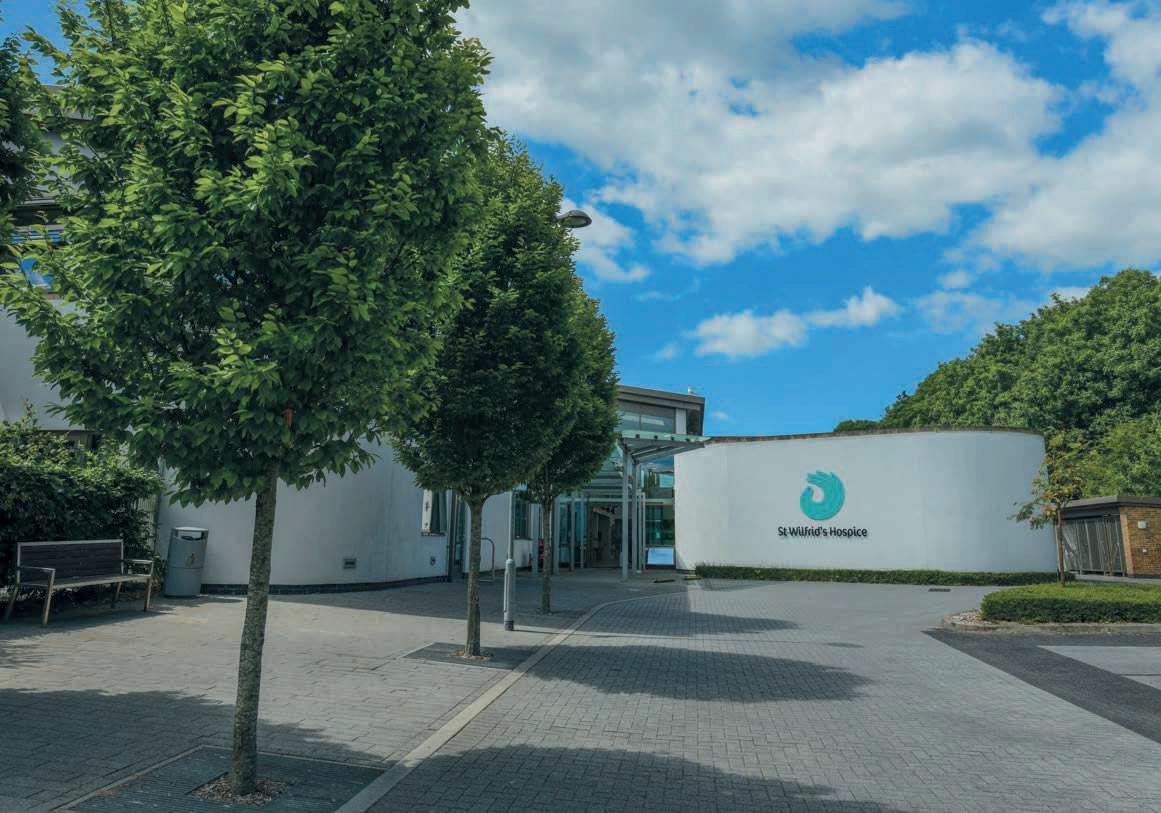
Our new plan sets out Five Strategic Ambitions
3
4
We will build a workforce fit for the future
5 We will build strong, influential partnerships within the Sussex Integrated Care System
We will build sustainable and resilient funding

Closer to You reflecting back
In 2017, the hospice launched its Closer to You strategy, aimed at bringing skilled, expert palliative and end of life care to more people across communities. In the five years since its inception, there have been many successes including:
• A 40% increase in patients supported, with a 50% increase in overall reach
• Community activity has doubled, with the development of five nursing hubs linked to Primary Care networks and a physical base in Uckfield Hospital
• NurseLine has handled a 60% increase in calls
• Care at Home has been established as a standalone, CHC-funded personal care operation, providing over 12,000 hours of care last year
• The development of five ‘nurse-led’ beds to allow for broader admissions criteria for inpatient beds
• Counselling support has more than doubled
• We have increased rehabilitative support through physiotherapy, occupational therapy and complementary therapies
• There has been an increase in support for people with non-cancer conditions, from just over a quarter to a third of total patients
The period has also seen a continuing focus on quality improvement. In 2021/22:
• 94% of urgent referrals were responded to within 24 hours
• 73% of patients died in their preferred place
• 83% of people supported by the community team rated their needs as completely met
• 87% of those supported by the community team reported they always visited as often as necessary
• 92% said it was always easy to get through to NurseLine
• 94% felt the involvement in decisions around their care and treatment was as much as they wanted
• 92% said they would be extremely likely to recommend St Wilfrid’s Hospice to friends and family.
To support these achievements, income has grown by more than £2 million overall, with a 50% growth in NHS income and 46% increase in donations over the period. The charity’s reserves have also grown healthily over the period – total reserves have increased from £14m to just under £20m.
The last two years also saw the extraordinary challenges caused by the Covid-19 pandemic. Whilst presenting severe pressures to the consistent operation of hospice services, there were also positive outcomes. This included a strengthening of the relationship with commissioners and partners across the health and social care system. Agile and flexible approaches to income generation were also required. This has seen areas such as retail recover well following the pandemic.
stwhospice.org 04 / 05
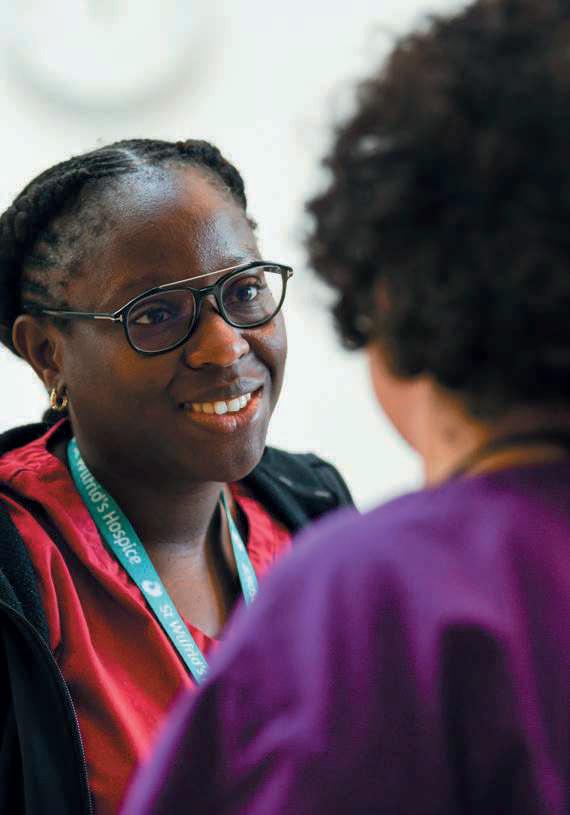
Our population in Sussex
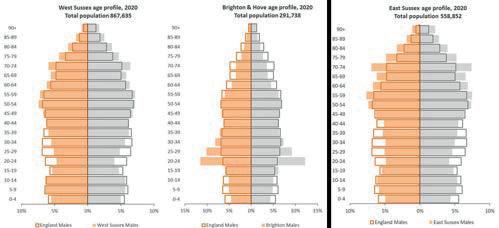
Recent health reforms have moved the provision of health and social care towards a population health approach. This aims to improve the physical and mental health outcomes and wellbeing of people within and across a defined population, while reducing health inequalities.
It requires working with communities and partner agencies. With an estimated 235,000 people living in St Wilfrid’s catchment area, we are supporting just over 40% of the East Sussex population of 559,000. The total Sussex population is 1.72m. Between 2010 and 2020 this population increased by approximately 7.6%, in line with the England average. Much of this growth is driven by inward migration rather than natural growth and in 2020 there were 4,000 more deaths than births across Sussex. The ONS projects a lower growth rate of 5.4% in the decade from 2020 to 2030. However, this hides differences in age groups, as the population aged 65 or over is projected to increase by 22% and over-85s by 25%+. The diagram below shows the age profile of the population in the three Sussex ‘places’.
stwhospice.org 06 / 07
We are still awaiting the release of most of the 2021 census data, although we know that the Eastbourne population has grown by 2.3% to 101,700 in the past 10 years, against a national average of 6.6%. On the other hand, the Wealden population has grown by 7.5%. In the 2011 census, 1 in 10 people said they were from an ethnic minority background, although this is concentrated in areas such as Brighton and Crawley, but this will have grown across the county in the past 10 years. Over 290,000 people said they had a limiting long-term illness and over 15,000 people aged 65 or over said they lived in a residential or nursing home. There are significant pockets of deprivation across Sussex, many concentrated along the coastal strip. Below is a breakdown and this shows that in Eastbourne, which makes up almost 50% of our catchment population, 20% lived in the most deprived quintile and a further 30% in the second most deprived. See diagram above.
Life expectancy in East Sussex in 2020 was 84 for a female and 80.1 for a male, but healthy life expectancy reduced to 63 for both sexes. Again, there are big variations from area to area, with a difference of 11.6 years between the best and the worst (Pier in Eastbourne having a life expectancy of 73.7 for males). The top causes of death and years of life lost can be seen in the table above.

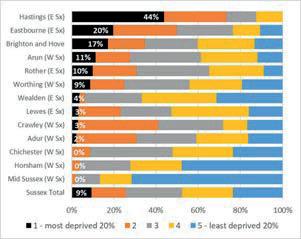
Looking ahead, the prediction is for total deaths in Sussex to grow by 19% between 2020 to 2030, which would equate to just over 20,000 deaths annually. Proportionately, just under 3,000 would be in St Wilfrid’s catchment area. The focus for this increase will be on the over-85s, as seen from the diagram above.
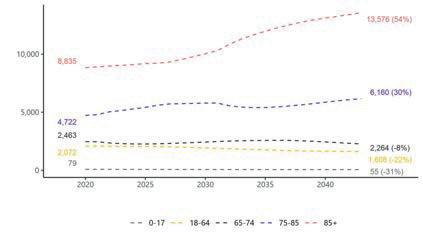
Where people die and from what cause also needs to be understood to determine how to prioritise resources and how to change care pathways. The diagram below shows the breakdown of people who died in Sussex in 2018/19 in terms of cause of death and where they died. See diagram below.
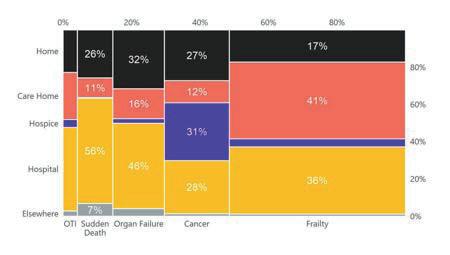
stwhospice.org 08 / 09
As expected, this shows a high number of cancer patients dying in hospices but a much lower number of people from other causes. Frailty is the single largest underlying cause of death, with the majority in a care home setting. Frailty can be described as a long-term health condition characterised by loss of physical, emotional and cognitive resilience as a result of the accumulation of multiple health problems. It is progressive and can make individuals particularly vulnerable to exposure to illness. In recent years, national policy development has often aligned the organisation of end-of-life care services with frailty. Frailty encompasses a broad and complex range of need, with different levels of severity. Many people with frailty would benefit from some element of palliative care, though not necessarily specialist hospice services. Organ failure results in a high number of deaths in a hospital setting, though many of these would be suitable for palliative care. The NHS Strategy Unit did a piece of work around health service use in the last two years of life for Brighton and Sussex University Hospitals NHS Trust in 2021, based on linking different datasets. This was mainly Sussex-wide hospital data rather than community, social care and GP information, so gives a partial view, but some of the findings were quite stark:
• 66% of people in Sussex say they would like to die at home but only 22% achieve this
• People from the most deprived communities are more likely to die in hospital than people from affluent areas, with the reverse true for care homes
• 35% of people die after being admitted to hospital as an emergency, often within two days
• Use of hospital beds is dominated by stays following an emergency admission
• There is a rapid increase in use of urgent care in the months leading up to death
• Over 80% attend A&E at least once in the last two years of their life
• Almost a quarter are in touch with mental health services
• Patterns of service use differ radically by cause of death, with those with non-cancer conditions accessing the least, in particular planned care. Planned care use in Sussex is lower than the national average
• Not all treatment adds value and can lead to a worsening of quality of life
• In the last two years of life £210 million is spent on hospital services for those who die, two thirds of this being on urgent care
• If patterns of care do not change, the current growth in deaths per annum suggests the ICS will need over 453 new beds by 2040.
Previous research has shown a relationship between place of death and experience of pain, with people who die in a hospice reporting the lowest level of pain at end of life compared with other settings. The NHS Strategy Unit applied research from the Office of Health Economics to those receiving or in need of palliative care in Sussex. Their assumption from this is that up to a third of palliative patients may have died with their pain uncontrolled, with the highest proportion in a home setting. This all poses many challenges to our future hospice provision but includes:
• The need to respond to a growing population, many of whom will be over 85 with poor health and health outcomes
• An increasing number of people with lifelimiting illness due to many causes in addition to those from cancer
• Increasing inequality and deprivation, which causes adverse effects on people’s wellbeing and health outcomes
• A significant number of people living in residential and nursing care homes.

stwhospice.org 10 / 11
Listening to the Patient and Carer Voice
In June and July 2022, we undertook some in-depth interviews with nine current patients, both in the inpatient unit and the community, and nine bereaved carers, to understand their perspective on care both from the hospice and the wider system.
Although this is only a small study, the qualitative feedback is informative and echoes more extensive responses to the VOICES survey of bereaved carers and Views on Care feedback:
• St Wilfrid’s specialist support is highly valued and is often transformative in terms of quality of life
• All parts of the system need better pain management approaches
• There is a need for better out of hours medical, nursing and personal care in the community
• There is a call for greater clarity about the interface between different health and care agencies and better coordination – ideally by hospices
• We need to be more intentional about developing end of life plans with people, including emotional, psychological and spiritual needs and to be clearer in communicating about end-of-life symptoms
• More end-of-life care training is required for primary and secondary care and for care homes
• There was recognition of the extent to which hospices are funded from voluntary income and a call for better NHS funding.
The future context
As we move towards a new strategic framework, there remain many opportunities to improve the experience of end-of-life care and support. It is still the case that St Wilfrid’s is only reaching directly about one third of all those who die in its catchment area each year.
It is equally important to acknowledge the key risks, challenges and gaps which will influence the provision of hospice care in the years ahead. The environment in which the hospice operates is in a period of significant change. Locally, the Sussex Integrated Care Board (ICB) came into being on 1st July 2022. A major change for the palliative and end of life care sector is the inclusion in the Health and Social Care Act 2022 of the legal duty for ICBs to commission palliative care services. NHS England has developed a new Commissioning and Investment Framework to give guidance to ICBs around the commissioning of end-oflife care services from both NHS bodies and the independent sector. The stated ambition over the next five years is that funding for core and specialist hospice care will transition from being primarily charitable sources to predominantly ICB funding. This will require the hospice to work in strong partnership with the ICB and the wider health and care system, as the process to agree fair funding arrangements progresses.
The National Ambitions Framework for Palliative and End of Life care (PEoLC) will provide the framework for the ICB to ensure a clear vision to commission a package of services across the whole system of health and social care. A key goal will be to improve equity of access to services and reduce inequity in outcomes and experience. The ICB recognise successes across Sussex, including the Sussex Hospices Collaborative, and a mature Sussexwide collaboration of commissioners, hospices
and acute and community providers. They also identify challenges and gaps, which include:
• Lack of consistent care co-ordination and response for Sussex PEoLC patients, particularly ‘out of hours’
• Insufficient data on PEoLC quality, access and workforce
• Risk to hospice sustainability – increasing demand, financial and workforce pressures
• Inconsistent governance and practice relating to end-of-life prescribing, administration and access to medications
• Continued variable uptake, quality, and capacity for Advance Care Planning (via the Recommended Summary Plan for Emergency Care and Treatment) across Sussex
• Variation in patients’ PEoLC offer on basis of funding source rather than need
• Significant capacity and workforce challenges
• Healthwatch patient engagement demonstrating shortcomings in Sussex advance care planning conversations, PeOLC personalisation, co-ordination and capacity, workforce knowledge and skills, and discharge planning and practice.
The economic landscape remains volatile and uncertain with a prediction of recession and continued growth in inflation. Planning to respond to these challenges will be critical. A clear and robust income generation strategy will work alongside the strategic framework to ensure a successful range of activity, which will be resilient to the pressures and risks posed.
stwhospice.org 12 / 13

An introduction to our new strategy
Enabling people to live well at the end of life.
The strategic framework to lead the hospice through the next five years must continue to keep the patient and their families at the centre. This will require the hospice to play its part in seeking to address the challenges and gaps described above. Flexibility and agility will be crucial, to respond to the ongoing changes across the health and care system and related strategic developments, and the transition to a new relationship with commissioners and partners. The National Ambitions Framework for PeOLC is the golden thread across these developments. It is therefore right that St Wilfrid’s ensures a strong presence for the Ambitions in its own strategic framework, to support a common language and understanding, as well as the right direction of travel. The core offer of the hospice will be to enable people to live well at the end of life. Five strategic ambitions will describe how this can be achieved. As an expert, specialist provider of care and support, we will continue to provide direct support for those most in need and use our influence and leadership to improve access to palliative care and reduce inequity for more people at the end of life in our area. We will be a strong collaborator to realise these ambitions.
Our Strategic Ambitions
Our core purpose: Enabling people to live well at the end of life
Under each strategic goal we have set out our intentions for how we move closer to achieving this purpose.
1. Across our communities we will lead improvements in end-of-life care, in line with the National Ambitions Framework for Palliative and End of Life Care What this will look like:
• Working innovatively with colleagues in the Integrated Care System to create new pathways to improve the care of people at the end of life
• Leading the provision of specialist, multidisciplinary support to meet physical, psychosocial, spiritual and practical needs in the hospice and the community, for patients, families, carers and the bereaved
• Increasing the proportion of people dying in our catchment area who are offered and in receipt of high-quality palliative care, through both direct and indirect support
• Improving equity of access to services, in particular for underserved groups – caseload to fully reflect local demography
• Coordinating activity to reach people earlier in their end-of-life journey, to enable them to plan and be in control
• Collaborating with others to ensure there is a responsive visiting and advice service available 24/7 for pain relief and other symptoms
• Enabling ‘compassionate communities’ of other health and care agencies, voluntary groups and individuals to play their part in palliative and end of life support including care homes
• Strengthening the patient/family voice and acting as their advocate within the health and care system.
stwhospice.org 14 / 15
2. We will continue to strive for excellence in all that we do
What this will look like:
• Providing outstanding care described by the five quality areas of our regulator the Care Quality Commission – safe, effective, caring, responsive and well-led
• Focussing on outcomes and impact for patients and families, collaborating with others to align our monitoring framework to ensure a consistent approach
• Investing in digital technology to improve and extend clinical service delivery, analysis and sharing of data and administration of the charity
• Developing a research capability to learn from our own work and that of others.
3. We will build strong, influential partnerships within the Sussex Integrated Care system
What this will look like:
• Developing a collaborative Education Hub with the other Sussex hospices, to provide specialist education and training to other parts of the health and care system, in particular care homes
• Working with the other Sussex hospices to align core activity to offer a consistent service across the county
• Joining forces to develop a Single Point of Contact for palliative and end of life care, to improve triaging and coordination of patients
• Working with GPs, Primary Care Networks and hospital teams to improve early identification and coordination and to avoid or reduce hospital stays at end of life
• Contributing to a strong hospice presence on the Sussex Palliative and End of Life Care Oversight Board and on other ICS decision-making bodies.
4. We will build a workforce fit for the future
What this will look like:
• Creating an optimal learning environment for the skills development of our teams, to offer a full career pathway, retain great staff and role model expert care
• Sustaining strong links with universities and colleges to be a placement of choice for clinical students
• Ensuring that our workforce is fully representative of the demography of our catchment area
• Putting in place good succession planning
• Working with others to take a wider system approach to workforce planning
• Developing the range and scope of volunteering roles
• Focussing on the wellbeing and resilience of the workforce, as a compassionate employer of choice.
5. We will build sustainable and resilient funding
What this will look like:
• Continuing to grow donated income through increasing the number of individual, corporate, trust and community group supporters and increasing retention through an effective donor journey.
• Growing retail Income through expansion of the shops portfolio from eight to twelve shops over the next three years and expanding our eCommerce business.
• Investing in legacy fundraising to build a future pipeline of legacy gifts
• Making common cause with the other Sussex hospices to increase levels of statutory funding for core services, with a view to achieving at least matched funding for these
• Achieving a greater balance to income streams, to build resilience
• Building connectedness and understanding with our stakeholders
• Focussing on cost-sharing opportunities with other hospices and agencies.
In planning our strategy, we have acknowledged the challenge of finding the right balance between continually developing our services and finding ways to respond to increasing demand in a climate of severe funding pressures.
References
Ambitions for Palliative and End of Life Care: A national framework for local action 2021-2026 (2021) National Palliative and End of Life Care Partnership.
Community services currency guidance: frailty and last year of life (2021) NHS

Palliative and End of Life Care: Statutory Guidance for Integrated Care Boards (ICBs). (2022) NHS Publication Reference PAR1673
Toolkit for general practice in supporting older people living with frailty. NHS England Wiltshire, J. and Battye, F. (2021) Health Service
Use in the last two years of life. NHS Strategy Unit. What are the most important health needs of our population across Sussex? Public Health paper to Sussex Integrated Care Board, July 2022.
Zamora, B, Cookson, G and Garau, M (2019)
Unrelieved Pain in Palliative Care in England. OHE Consulting Report, London. Office of Health Economics.











